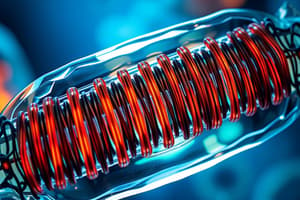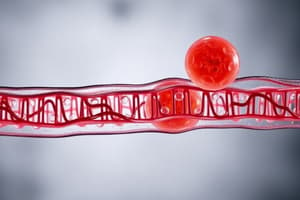Podcast
Questions and Answers
What is the function of a cell wall?
What is the function of a cell wall?
- Controls what enters and exits the cell
- A ridged outer layer of a plant cell (correct)
- Produces energy
- Stores food and water
What is cytoplasm?
What is cytoplasm?
Gel-like fluid where the organelles are found
What is the primary function of mitochondria?
What is the primary function of mitochondria?
Produces the energy a cell needs to carry out its functions
What do lysosomes do?
What do lysosomes do?
What is the function of vacuoles?
What is the function of vacuoles?
What is the role of Golgi bodies?
What is the role of Golgi bodies?
What do chloroplasts do?
What do chloroplasts do?
What is the function of the endoplasmic reticulum?
What is the function of the endoplasmic reticulum?
What do ribosomes do?
What do ribosomes do?
What is the nucleus?
What is the nucleus?
What does the nucleolus do?
What does the nucleolus do?
What is chromatin?
What is chromatin?
Flashcards are hidden until you start studying
Study Notes
Cell Wall
- A rigid outer layer found exclusively in plant cells.
- Provides structural support and protection.
Cytoplasm
- A gel-like fluid residing within the cell membrane.
- Serves as the medium where organelles are suspended and metabolic activities occur.
Mitochondria
- Known as the powerhouse of the cell.
- Generates adenosine triphosphate (ATP), the energy currency for various cellular functions.
Lysosomes
- Organelles that contain digestive enzymes.
- Responsible for breaking down food, cellular debris, and worn-out organelles.
Vacuoles
- Storage sacs in the cell that hold food, water, waste products, and other materials.
- Larger in plant cells, aiding in maintaining internal pressure.
Golgi Bodies
- Function as the cell's packaging and distribution center.
- Receives proteins and materials from the endoplasmic reticulum (ER), modifies them, and sends them to their destination.
Chloroplasts
- Unique to plant cells, these organelles capture sunlight.
- Utilize solar energy to synthesize food through photosynthesis.
Endoplasmic Reticulum (ER)
- Network of membranes that assist in transporting proteins and other materials.
- Two types: rough ER (with ribosomes) and smooth ER (without ribosomes), serving different functions in the cell.
Ribosomes
- Molecular machines that assemble amino acids into proteins.
- Can be found freely floating in the cytoplasm or attached to the rough ER.
Nucleus
- The control center of the cell; houses genetic material (DNA).
- Regulates cellular activities by controlling gene expression.
Nucleolus
- Located within the nucleus, plays a crucial role in ribosome production.
- Composed of proteins and RNA, facilitating the assembly of ribosomes.
Chromatin
- Consists of DNA strands that are tightly coiled and stored within the nucleus.
- Contains genetic information essential for directing cellular functions and heredity.
Studying That Suits You
Use AI to generate personalized quizzes and flashcards to suit your learning preferences.




